Laser Welding of ARMOX 500T Steel
Abstract
:1. Introduction
2. Materials and Methods
3. Results and Discussion
3.1. Testing the Shape of Fusion Zone and the Quality of Bead-on-Plate Welds
3.2. Microstructure and Hardness Distribution of Butt Joints
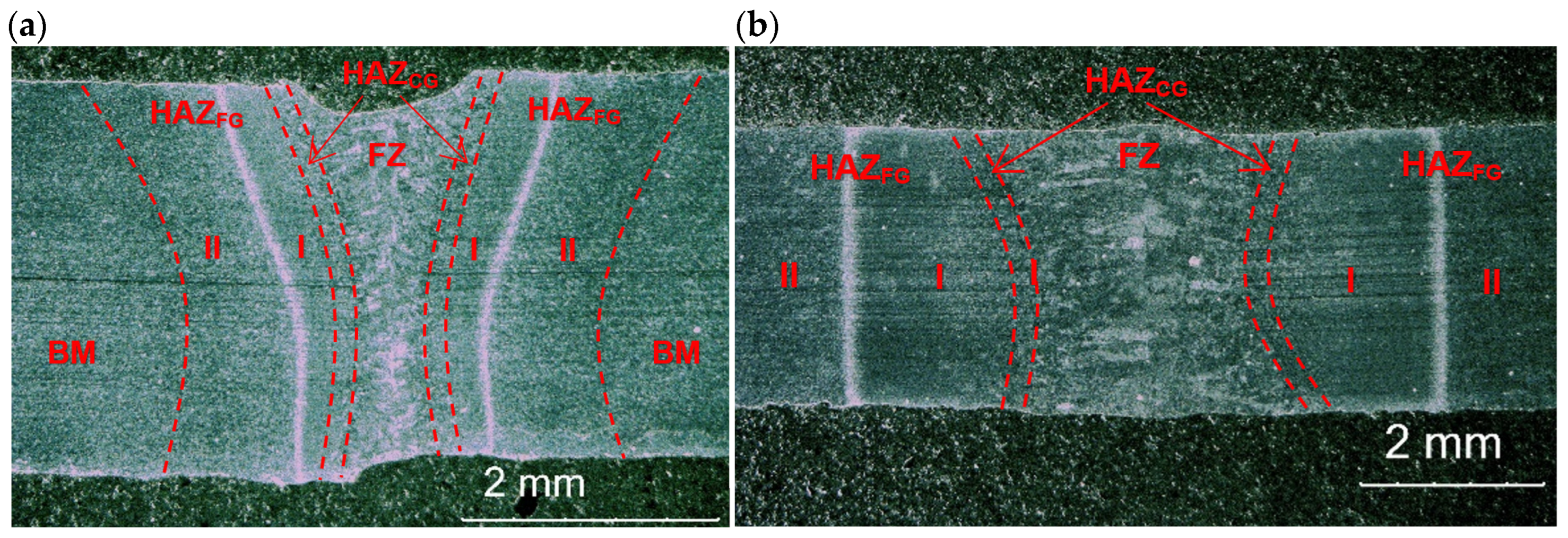
3.3. Mechanical Properties and Fracture Mode of Butt Joints
4. Conclusions
- -
- Low welding speed of 0.5 m/min and Y-type shape of fusion zone favor porosity in the bottom of the weld (root porosity), which is a common problem during keyhole laser welding.
- -
- Welding at higher speed provided a columnar (I configuration) or hourglass (X configuration) shape of the fusion zone, and eliminated the risk of porosity. Therefore, it was possible to ensure satisfactory quality of butt joints, characterized by a proper geometry, and no internal defects.
- -
- Microstructure of the fusion zone and HAZ was related directly to the energy input of laser welding, thus thermal conditions of solidification and cooling rates. The dominant phase constituent in the fusion zone and HAZ was martensite. The fusion zone consisted of columnar and equiaxed grains with the size of martensite dependent on the energy input of laser welding process.
- -
- The butt joints were characterized by significantly lower microhardness in HAZ due to transformation of microstructure into bainitic in the specific zone. Therefore, the static tensile strength of the joints was lower that the base metal. Impact tests conducted at reduced temperature (−20 °C) showed a reduction of the impact toughness by approx. 25–30%, if compared to the values achieved at room temperature. The fracture surface of samples tested at −20 °C exhibited clearly a cleavage fracture mode, while the samples tested at 20 °C exhibited a mixed mode of fracture with some dimples.
- -
- Narrow weld and HAZ may be beneficial from the point of view of the ballistic performance of the butt joint of armor plates.
- -
- It is planned to continue research in the field of laser welding greater thicknesses of armor plates.
Author Contributions
Funding
Institutional Review Board Statement
Data Availability Statement
Acknowledgments
Conflicts of Interest
References
- Fei, Z.; Pan, Z.; Cuiuri, D.; Li, H.; Gazder, A.A. A Combination of Keyhole GTAW with a Trapezoidal Interlayer: A New Insight into Armour Steel Welding. Materials 2019, 12, 3571. [Google Scholar] [CrossRef] [PubMed]
- Jena, P.; Mishra, B.; Rameshbabu, M.; Babu, A.; Singh, A.; Sivakumar, K.; Bhat, T.B. Effect of heat treatment on mechanical and ballistic properties of a high strength armour steel. Int. J. Impact Eng. 2010, 37, 242–249. [Google Scholar] [CrossRef]
- El-Fawakhry, M.K.; Fathy, A.M. The Effect of Bad Heat Treatment Technology on Failure Mode of Armor Steel Sheet under EN1522 Ballistic Test. Int. J. Mater. Technol. Innov. (IJMTI) 2021, 1, 30–44. [Google Scholar] [CrossRef]
- Starczewski, L.; Szczech, S.; Tudyka, D. Tests of armour steels in view of their protective efficiency. Prace IMŻ 2010, 62, 110–117. [Google Scholar]
- Khan, W.; Tufail, M.; Chandio, A.D. Characterization of Microstructure, Phase Composition, and Mechanical Behavior of Ballistic Steels. Materials 2022, 15, 2204. [Google Scholar] [CrossRef] [PubMed]
- Magudeeswaran, G.; Balasubramanian, V.; Madhusudhan Reddy, G. Effect of welding consumables on hydrogen induced cracking of armour grade quenched and tempered steel welds. Ironmak. Steelmak. 2008, 35, 549–560. [Google Scholar] [CrossRef]
- Turichin, G.; Kuznetsov, M.; Klimova-Korsmik, O.; Sklyar, M.; Zhitenev, A.; Kurakin, A.; Pozdnyakov, A. Laser-Arc hybrid welding perspective ultra-high strength steels: Influence of the chemical composition of weld metal on microstructure and mechanical properties. Procedia CIRP 2018, 74, 752–756. [Google Scholar] [CrossRef]
- Kumar, S.N.; Balasubramanian, V.; Malarvizhi, S.; Rahman, A.H.; Balaguru, V. Effect of welding consumables on shielded metal arc welded ultra high hard armour steel joints. J. Mech. Behav. Mater. 2022, 31, 8–21. [Google Scholar] [CrossRef]
- Skowrońska, B.; Szulc, J.; Bober, M.; Baranowski, M.; Chmielewski, T. Selected properties of RAMOR 500 steel welded joints by hybrid PTA-MAG. J. Adv. Join. Process. 2022, 5, 100111. [Google Scholar] [CrossRef]
- Górka, J.; Stano, S. Microstructure and Properties of Hybrid Laser Arc Welded Joints (Laser Beam-MAG) in Thermo-Mechanical Control Processed S700MC Steel. Metals 2018, 8, 132. [Google Scholar] [CrossRef]
- Janicki, D. Disk laser welding of armor steel. Arch. Metall. Mater. 2014, 59, 1641–1646. [Google Scholar] [CrossRef]
- Bassett, J. Laser welding of high hardness armour steel. Sci. Technol. Weld. Join. 1998, 3, 244–248. [Google Scholar] [CrossRef]
- Grajcar, A.; Morawiec, M.; Rozanski, M.; Stano, S. Twin-spot laser welding of advanced high-strength multiphase microstructure steel. Opt. Laser Technol. 2017, 92, 52–61. [Google Scholar] [CrossRef]
- Sowards, J.W.; Hussey, D.S.; Jacobson, D.L.; Ream, S.; Williams, P. Correlation of Neutron-Based Strain Imaging and Mechanical Behavior of Armor Steel Welds Produced with the Hybrid Laser Arc Welding Process. J. Res. Nat. Inst. Stand. Technol. 2018, 123, 1. [Google Scholar] [CrossRef] [PubMed]
- Lisiecki, A. Welding of Thermomechanically Rolled Fine-Grain Steel by Different Types of Lasers. Arch. Metall. Mater. 2014, 59, 1625–1631. [Google Scholar] [CrossRef]
- Kurc-Lisiecka, A.; Lisiecki, A. Laser welding of new grade of advanced high strength steel DOMEX 960. Mater. Tehnol. 2017, 51, 199–204. [Google Scholar] [CrossRef]
- Kurc-Lisiecka, A. Impact toughness of laser-welded butt joints of the new steel grade Strenx 1100MC. Mater. Tehnol. 2017, 51, 643–649. [Google Scholar] [CrossRef]
- Landowski, M.; Świerczyńska, A.; Rogalski, G.; Fydrych, D. Autogenous Fiber Laser Welding of 316L Austenitic and 2304 Lean Duplex Stainless Steels. Materials 2020, 13, 2930. [Google Scholar] [CrossRef] [PubMed]
- Kurc-Lisiecka, A.; Lisiecki, A. Weld Metal Toughness of Autogenous Laser-Welded Joints of High-Strength Steel Domex 960. Mater. Perform. Charact. 2019, 8, 20190071. [Google Scholar] [CrossRef]
- Kurc-Lisiecka, A.; Lisiecki, A. Hybrid Laser-GMA Welding of High-Strength Steel Grades. Mater. Perform. Charact. 2019, 8, 20190070. [Google Scholar] [CrossRef]
- Lisiecki, A. Effect of Heat Input During Disk Laser Bead-On-Plate Welding of Thermomechanically Rolled Steel on Penetration Characteristics and Porosity Formation in The Weld Metal. Arch. Metall. Mater. 2016, 61, 93–102. [Google Scholar] [CrossRef]
- Norris, J.T.; Robino, C.V.; Hirschfeld, D.A.; Perricone, M.J. Effects of Laser Parameters on Porosity Formation: Investigating Millimeter Scale Continuous Wave Nd:YAG Laser Welds. Weld. J. 2011, 90, 198–203. [Google Scholar]
- Torkamany, M.J.; Sabbaghzadeh, J.; Hamedi, M.J. Effect of laser welding mode on the microstructure and mechanical performance of dissimilar laser spot welds between low carbon and austenitic stainless steels. Mater. Des. 2012, 34, 666–672. [Google Scholar] [CrossRef]
- Pandey, C.; Saini, N.; Mahapatra, M.; Kumar, P. Study of the fracture surface morphology of impact and tensile tested cast and forged (C&F) Grade 91 steel at room temperature for different heat treatment regimes. Eng. Fail. Anal. 2017, 71, 131–147. [Google Scholar]
- PN-EN ISO 17637:2017-02; Non-Destructive Testing of Welded Joints—Visual Testing of Welded Joints. Polish Committee for Standardization: Warszawa, Poland, 2017.
- PN-EN ISO 9015-2:2016-04; Destructive Testing of Welded Metal Joints—Hardness Testing—Part 2: Microhardness Testing of arc Welded Joints. Polish Committee for Standardization: Warszawa, Poland, 2016.
- PN-EN ISO 5173:2023-06; Destructive Testing of Welds in Metal Materials—Bending Testing. Polish Committee for Standardization: Warszawa, Poland, 2023.
- PN-EN ISO 148-1:2017-02; Metals—Charpy Impact Test—Part 1: Test Method. Polish Committee for Standardization: Warszawa, Poland, 2017.
- PN-EN ISO 4136:2022-12; Destructive Testing of Welded Metal Joints—Tensile Test of Transverse Samples. Polish Committee for Standardization: Warszawa, Poland, 2022.
- Dak, G.; Sirohi, S.; Pandey, C. Study on microstructure and mechanical behavior relationship for laser-welded dissimilar joint of P92 martensitic and 304L austenitic steel. Int. J. Press. Vessel. Pip. 2022, 196, 104629. [Google Scholar] [CrossRef]
- Wang, Z.Q.; Wang, X.L.; Nan, Y.R.; Shang, C.J.; Wang, X.M.; Liu, K.; Chen, B. Effect of Ni content on the microstructure and mechanical properties of weld metal with both-side submerged arc welding technique. Mater. Charact. 2018, 138, 67–77. [Google Scholar] [CrossRef]
- Almeida, D.T.; Clarke TG, R.; de Souza JH, C.; Haupt, W.; de Lima MS, F.; Mohrbacher, H. The effect of laser welding on microstructure and mechanical properties in heavy-gage press hardening steel alloys. Mater. Sci. Eng. A 2021, 821, 141341. [Google Scholar] [CrossRef]
- Guo, W.; Cai, Y.; Wang, B.; Mu, W.; Xin, D. Effect of microstructure synergism on cryogenic toughness for CGHAZ of low-carbon martensitic steel containing nickel. Mater. Sci. Eng. A 2022, 830, 142240. [Google Scholar] [CrossRef]
- Kozłowska, A.; Janik, A.; Radwański, K.; Grajcar, A. Microstructure Evolution and Mechanical Stability of Retained Austenite in Medium-Mn Steel Deformed at Different Temperatures. Materials 2019, 12, 3042. [Google Scholar] [CrossRef]
- Hyeon-Seok, L.; Jimin, L.; Young-Beum, S.; Hong-Kyu, K.; Byoungchul, H. Effect of Tempering Temperature on the Microstructure and Mechanical Properties of ARMOX 500T Armor Plate. Korean J. Mater. Res. 2017, 27, 359–363. [Google Scholar] [CrossRef]
- Adamiak, M.; Tomiczek, B.; Górka, J.; Czupryński, A. Joining of the AMC Composites Reinforced with Ti3Al Intermetallic Particles by Resistance Butt Welding. Arch. Metall. Mater. 2016, 61, 847–852. [Google Scholar] [CrossRef]
- Adamiak, M.; Czupryński, A.; Kopyść, A.; Monica, Z.; Olender, M.; Gwiazda, A. The Properties of Arc-Sprayed Aluminum Coatings on Armor-Grade Steel. Metals 2018, 8, 142. [Google Scholar] [CrossRef]
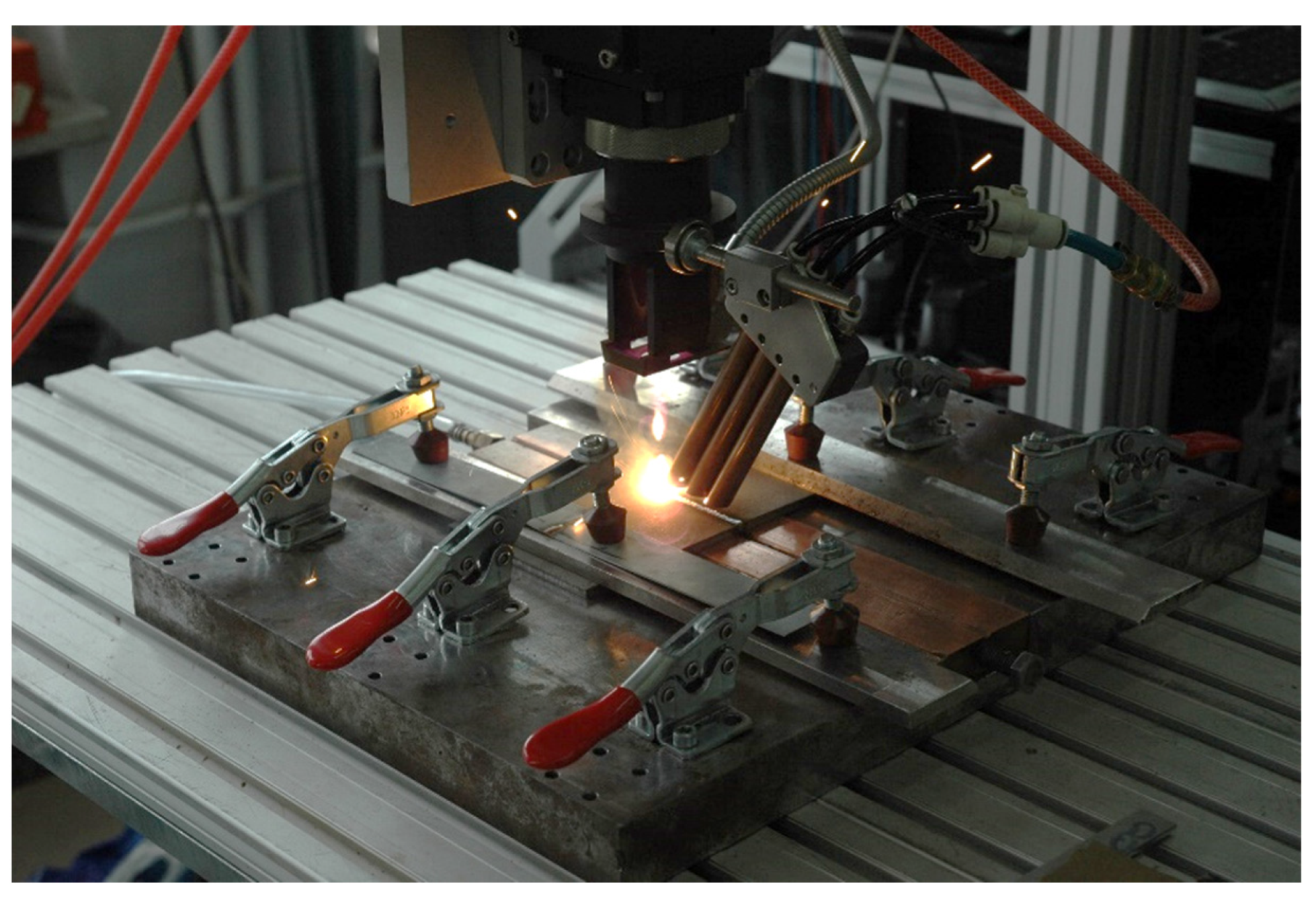
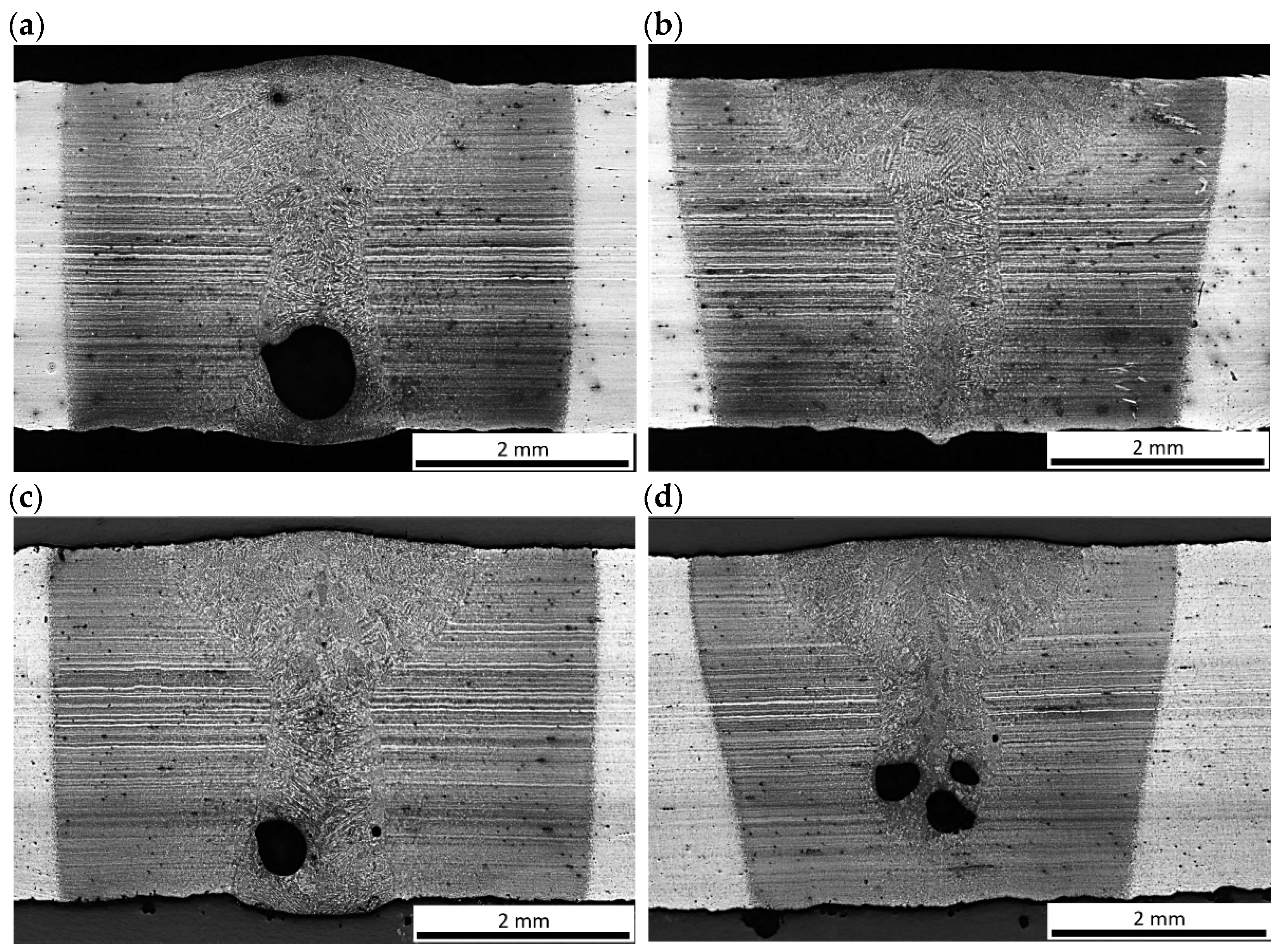
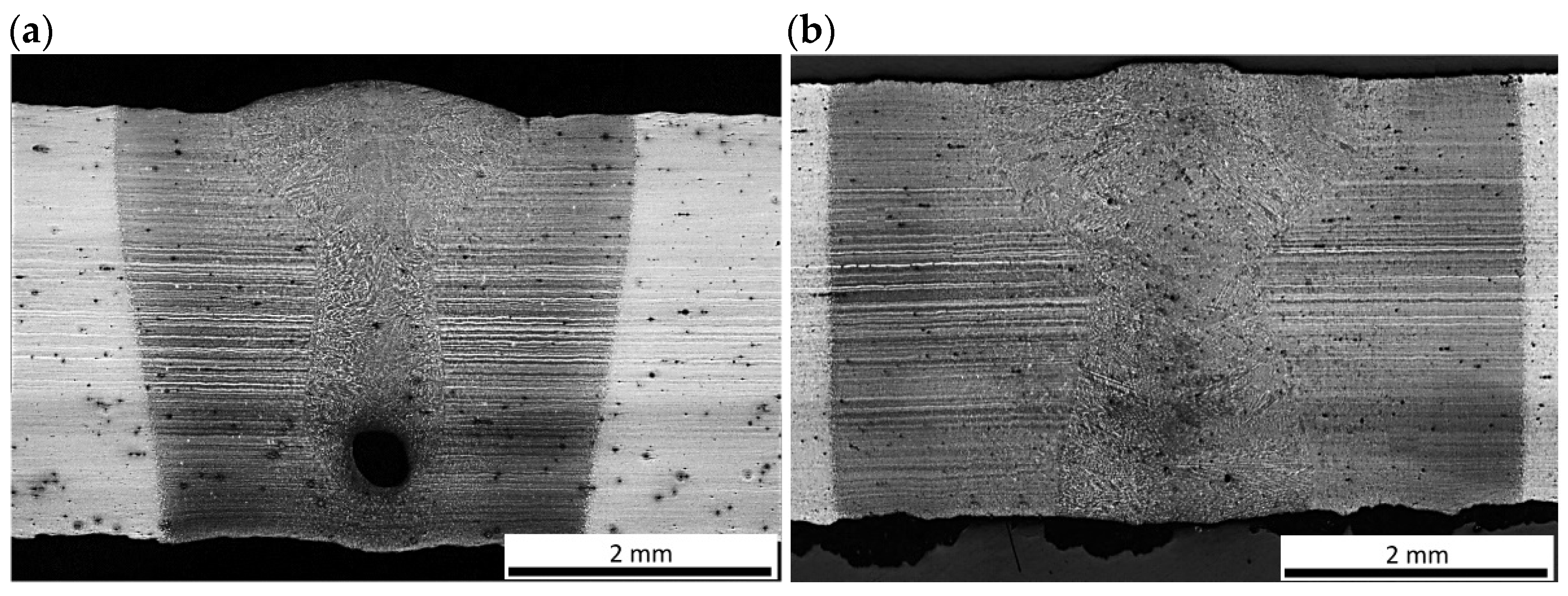

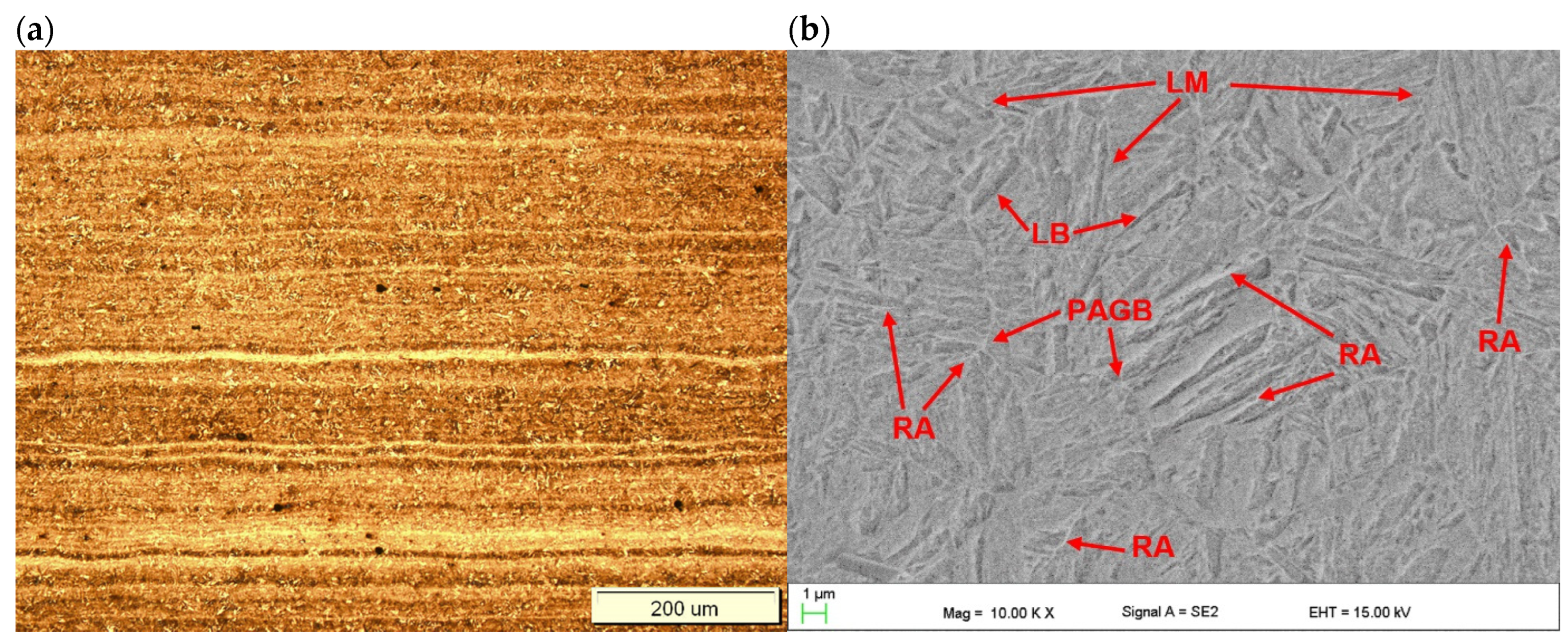
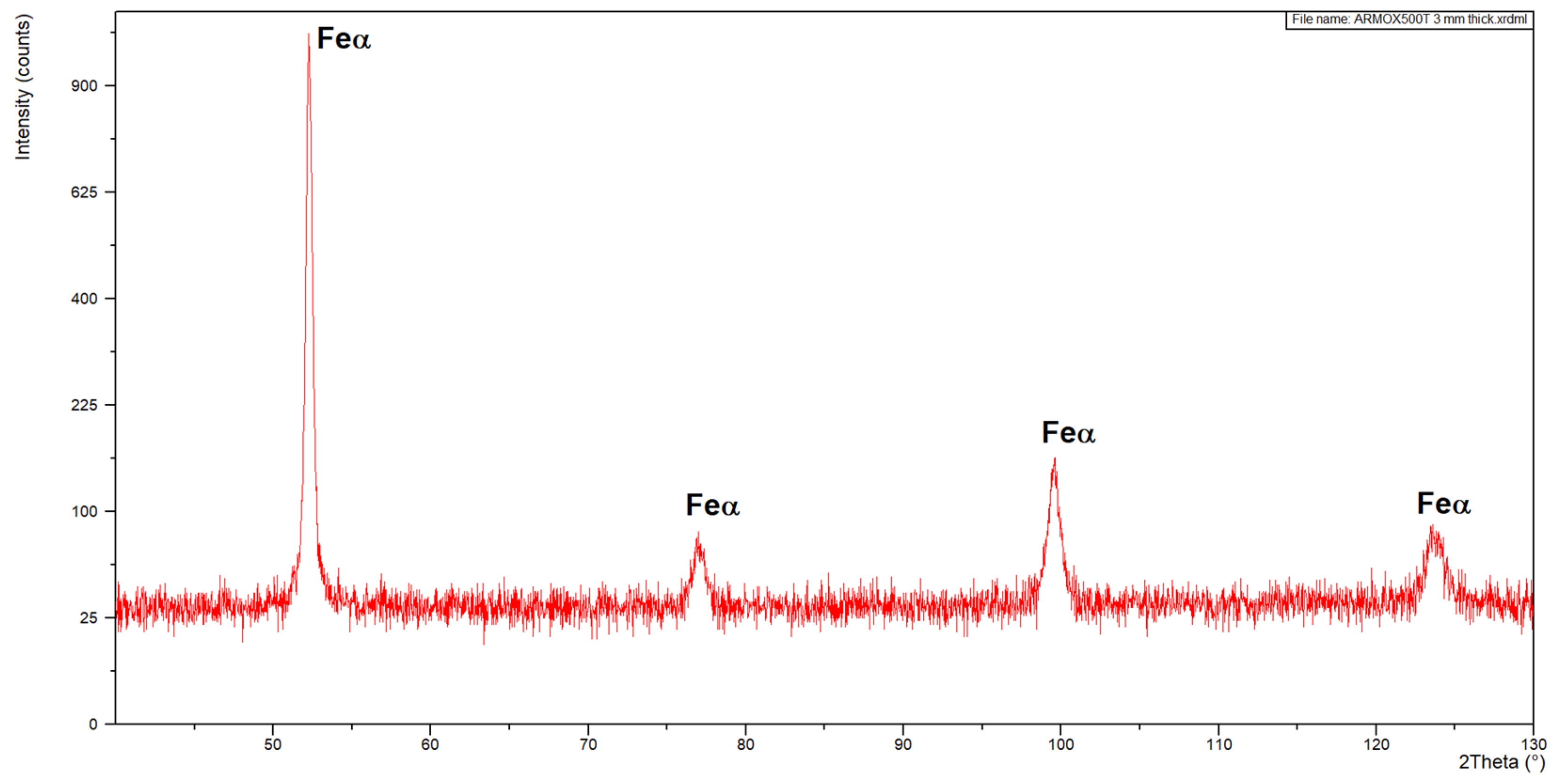
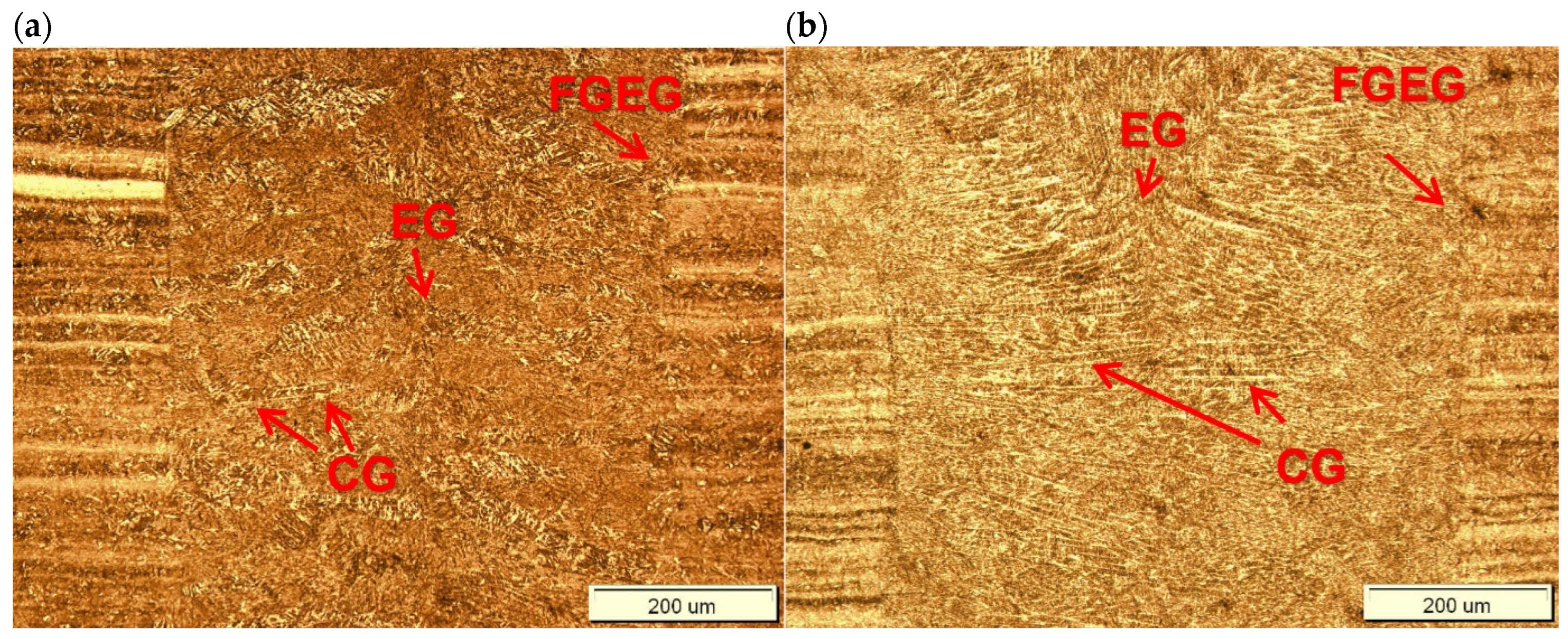
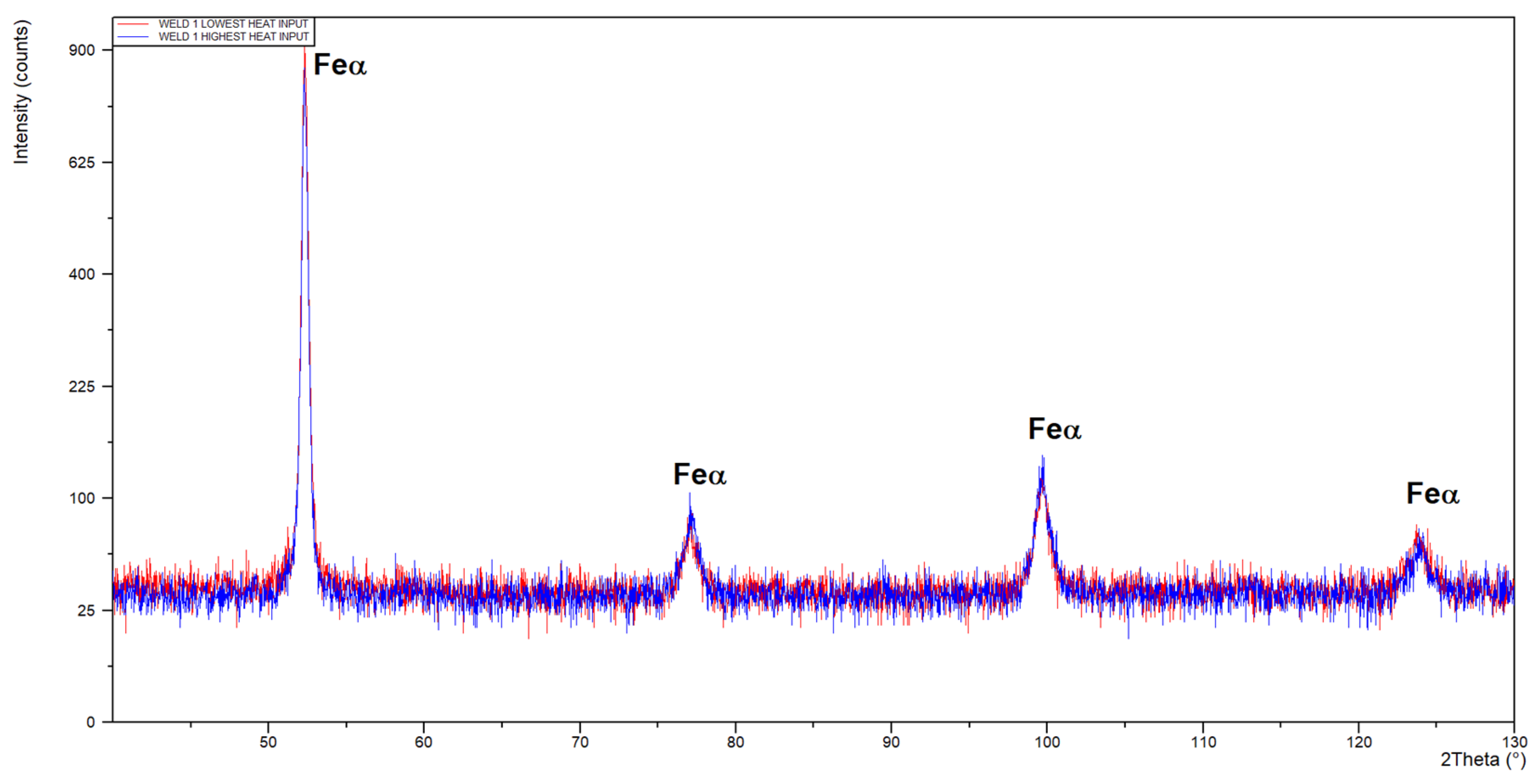
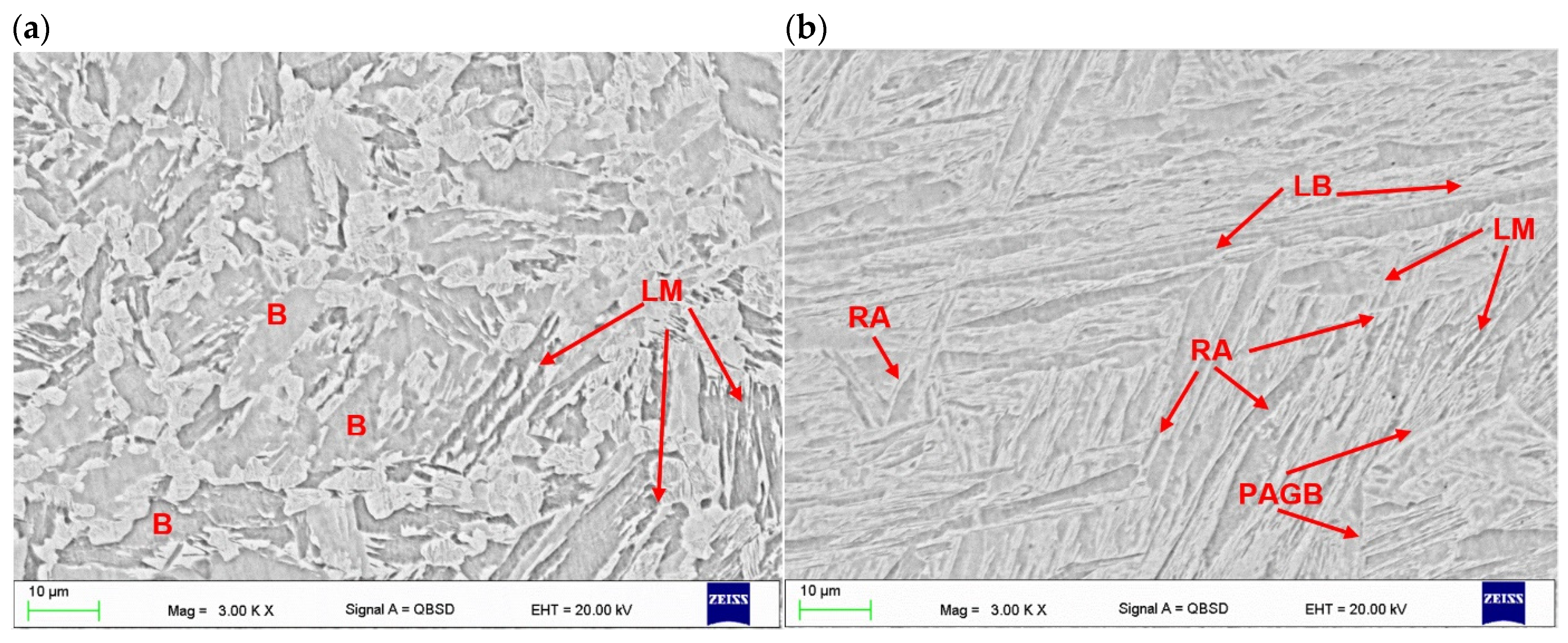

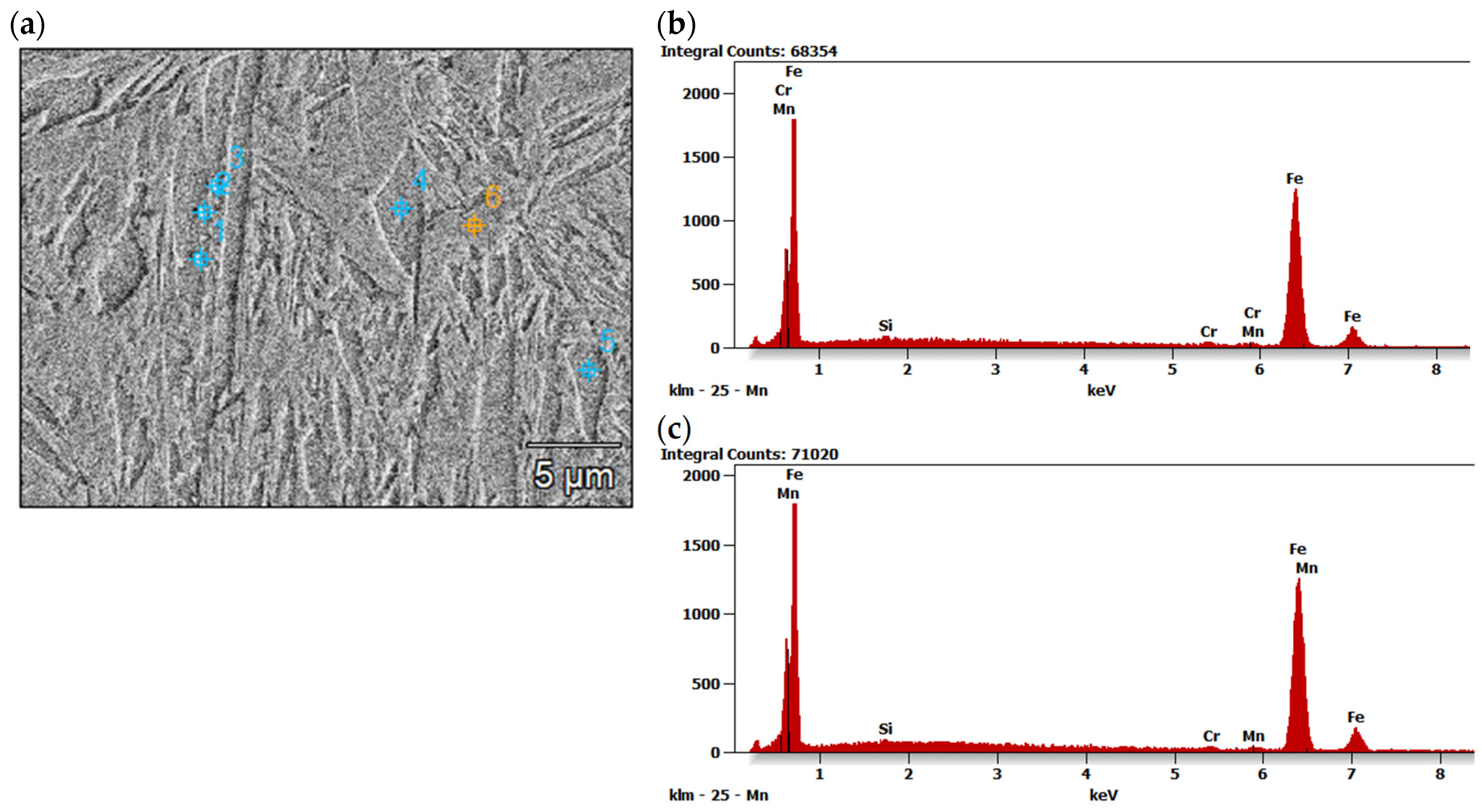


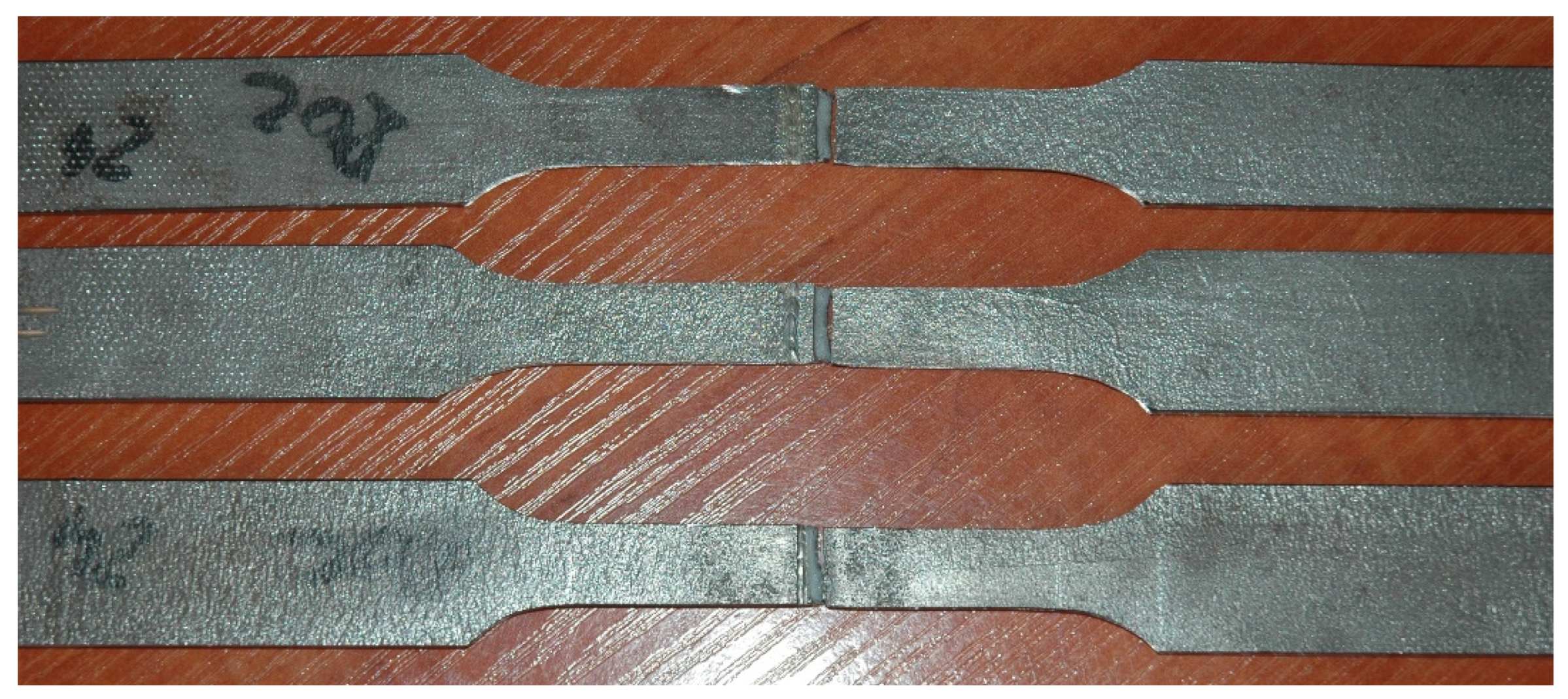
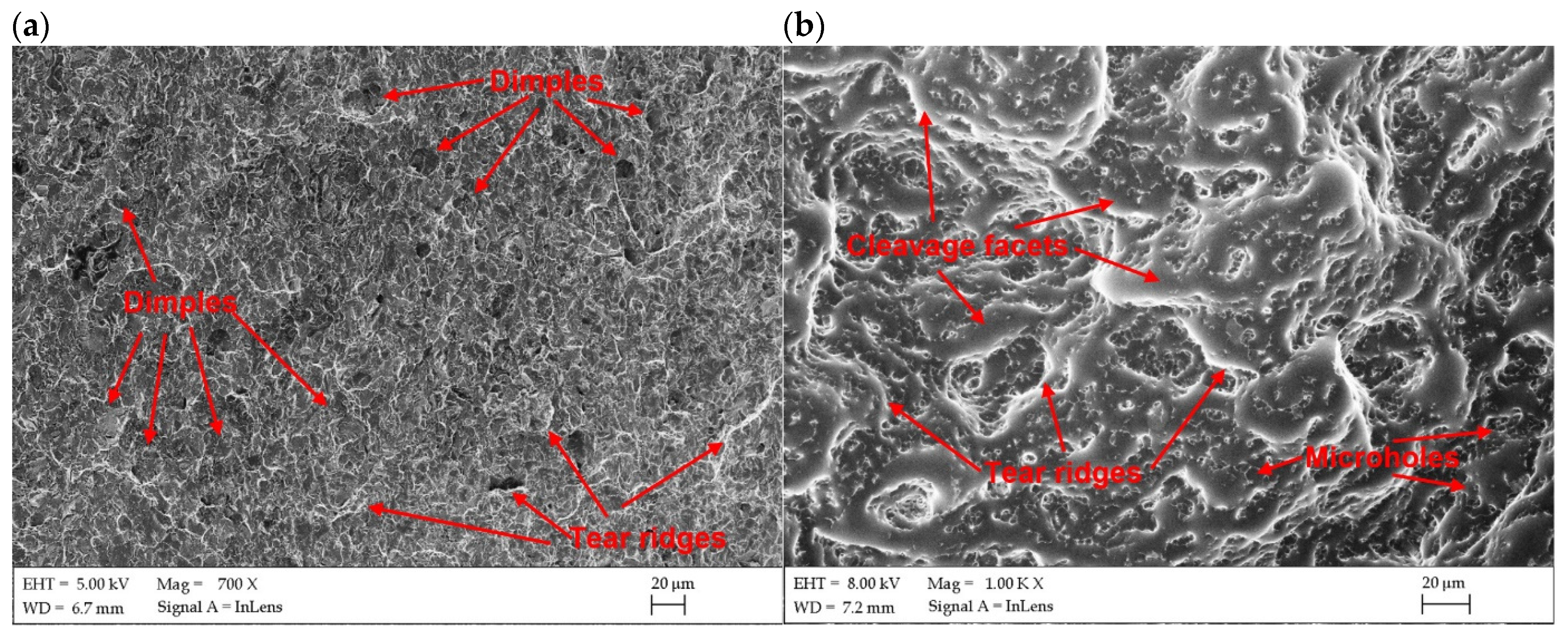
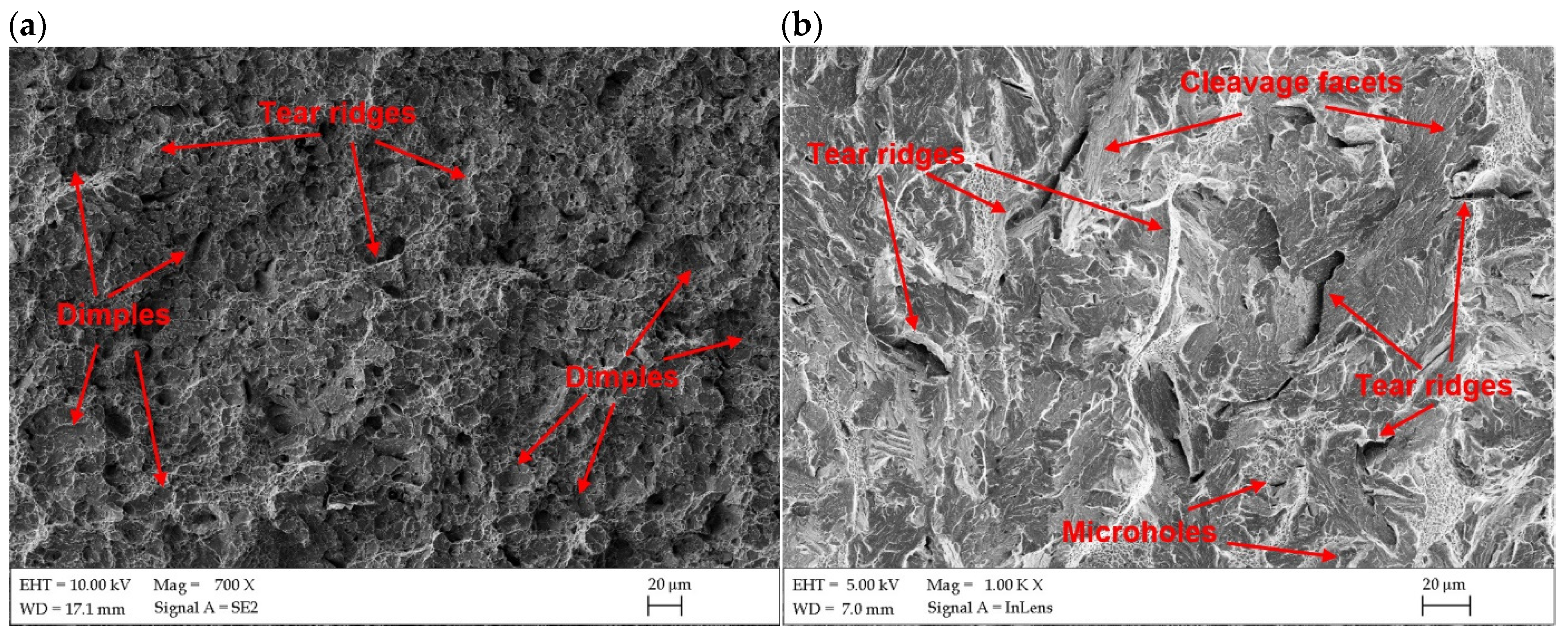
| Accor. to | C | Mn | Si | P | S | Cr | Ni | Mo | B |
|---|---|---|---|---|---|---|---|---|---|
| SSAB | 0.32 | 1.2 | 0.4 | 0.01 | 0.003 | 1.0 | 1.8 | 0.7 | 0.005 |
| Tested | 0.28 | 1.1 | 0.2 | - | - | 0.88 | 1.4 | 0.6 | - |
| Accor. to | Hardness, HBW | Minimum Yield Strength Rp0.2, MPa | Tensile Strength Rm, MPa | Total Elongation, A5, % | Total Elongation, A50, % | Notch Impact Energy at −40 °C, KV, J |
|---|---|---|---|---|---|---|
| SSAB | 480–540 | 1250 | 1450–1750 | 8 | 10 | 32 |
| Tested | - | 1298 | 1553 | 8.2 | 11 | 22 |
| Weld Bead No. | Output Laser Power kW | Welding Speed m/min | Focal Position * mm | Energy Input ** J/mm | Width of the Weld Face mm | Width of the Weld Root/Penetration Depth mm | Fusion Zone Shape | Remarks |
|---|---|---|---|---|---|---|---|---|
| B1 | 1.0 | 0.5 | 0 | 120 | 2.0 | -/2.7 | Y | L, P |
| B2 | 1.25 | 0.5 | 0 | 150 | 2.4 | 1.3 | X | L, P |
| B3 | 1.25 | 0.5 | 1.5 | 150 | 3.0 | 0.3 | X | F |
| B4 | 1.25 | 0.5 | −1.5 | 150 | 2.5 | 1.3 | Y | F, P |
| B5 | 1.25 | 0.5 | −3.0 | 150 | 2.7 | -/2.5 | Y | L, P |
| B6 | 1.5 | 0.5 | 0 | 180 | 2.6 | 1.8 | X | F |
| B7 | 1.5 | 1.0 | 0 | 90 | 2.7 | 1.2 | Y | F |
| B8 | 3.0 | 2.0 | 0 | 90 | 1.8 | 2.5 | X | F |
| B9 | 3.0 | 2.5 | 0 | 70 | 1.4 | 2.3 | X | F,H |
| Weld Bead No. | Output Laser Power kW | Welding Speed m/min | Focal Position * mm | Energy Input J/mm | Width of the Weld Face mm | Width of the Weld Root | Fusion Zone Shape | Remarks |
|---|---|---|---|---|---|---|---|---|
| BJ1 | 1.5 | 0.5 | 0 | 180 | 2.6 | 2.8 | X | FP |
| BJ2 | 3.0 | 2.5 | 0 | 70 | 2.5 | 1.3 | Y | FP,U |
| Tested Region | Si | Cr | Mn | Fe | ||||
|---|---|---|---|---|---|---|---|---|
| Wt.% | At.% | Wt.% | At.% | Wt.% | At.% | Wt.% | At.% | |
| Point 1 | 0.4 | 0.8 | 0.9 | 1.0 | 1.4 | 1.4 | 97.3 | 96.8 |
| Point 2 | 0.4 | 0.7 | 1.1 | 1.1 | 1.1 | 1.2 | 97.4 | 97.0 |
| Point 3 | 0.3 | 0.7 | 1.0 | 1.0 | 1.1 | 1.1 | 97.6 | 97.2 |
| Point 4 | 0.3 | 0.6 | 0.7 | 0.7 | 0.9 | 1.0 | 98.1 | 97.7 |
| Point 5 | 0.4 | 0.9 | 0.8 | 0.9 | 1.8 | 1.9 | 96.9 | 96.4 |
| Point 6 | 0.5 | 1.1 | 0.9 | 1.0 | 1.3 | 1.3 | 97.2 | 96.6 |
| Joint/Sample Type | Test Type | Bending Angle, ° | Remarks/Location of Failure |
|---|---|---|---|
| JA (70 J/mm) | Face bend | 35 | Longitudinal and transverse fracture along the entire width/HAZ/FZ |
| Root bend | 32 | Longitudinal fracture along the entire width/HAZ | |
| JB (180 J/mm) | Face bend | 25 | Longitudinal fracture along the entire width/HAZ |
| Root bend | 28 | Longitudinal fracture along the entire width/HAZ |
| Joint Type | Sample No. | Tensile Strength Rm, MPa | Location of Failure |
|---|---|---|---|
| JA (70 J/mm) | JA1 | 1373.09 | FZ/HAZ |
| JA2 | 1369.14 | FZ/HAZ | |
| JB (180 J/mm) | JB1 | 1402.39 | HAZ (weakest zone) |
| JB2 | 1401.29 | HAZ (weakest zone) |
| Joint Type | Temperature of Charpy V–Notch Test | Mean Value of Absorbed Impact Energy, J | Mean Value of Impact Toughness, J/cm2 |
|---|---|---|---|
| JA (70 J/mm) | 20 °C | 11.4 | 34.2 |
| −20 °C | 8.6 | 25.8 | |
| JB (180 J/mm) | 20 °C | 13.3 | 39.9 |
| −20 °C | 9.5 | 28.5 |
Disclaimer/Publisher’s Note: The statements, opinions and data contained in all publications are solely those of the individual author(s) and contributor(s) and not of MDPI and/or the editor(s). MDPI and/or the editor(s) disclaim responsibility for any injury to people or property resulting from any ideas, methods, instructions or products referred to in the content. |
© 2024 by the authors. Licensee MDPI, Basel, Switzerland. This article is an open access article distributed under the terms and conditions of the Creative Commons Attribution (CC BY) license (https://creativecommons.org/licenses/by/4.0/).
Share and Cite
Lisiecki, A.; Kurc-Lisiecka, A.; Pakieła, W.; Chrobak, G.; Batalha, G.F.; Adamiak, M. Laser Welding of ARMOX 500T Steel. Materials 2024, 17, 3427. https://doi.org/10.3390/ma17143427
Lisiecki A, Kurc-Lisiecka A, Pakieła W, Chrobak G, Batalha GF, Adamiak M. Laser Welding of ARMOX 500T Steel. Materials. 2024; 17(14):3427. https://doi.org/10.3390/ma17143427
Chicago/Turabian StyleLisiecki, Aleksander, Agnieszka Kurc-Lisiecka, Wojciech Pakieła, Grzegorz Chrobak, Gilmar Ferreira Batalha, and Marcin Adamiak. 2024. "Laser Welding of ARMOX 500T Steel" Materials 17, no. 14: 3427. https://doi.org/10.3390/ma17143427
APA StyleLisiecki, A., Kurc-Lisiecka, A., Pakieła, W., Chrobak, G., Batalha, G. F., & Adamiak, M. (2024). Laser Welding of ARMOX 500T Steel. Materials, 17(14), 3427. https://doi.org/10.3390/ma17143427











